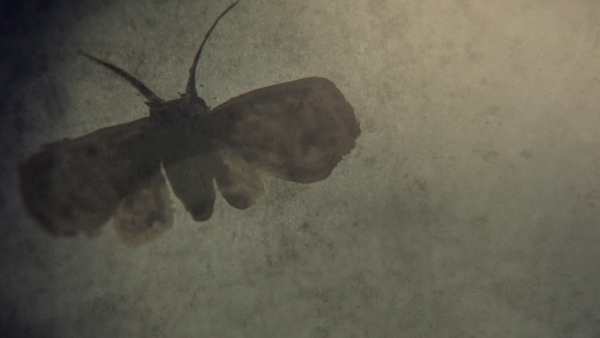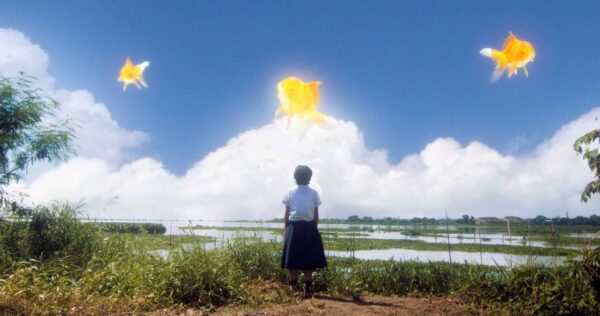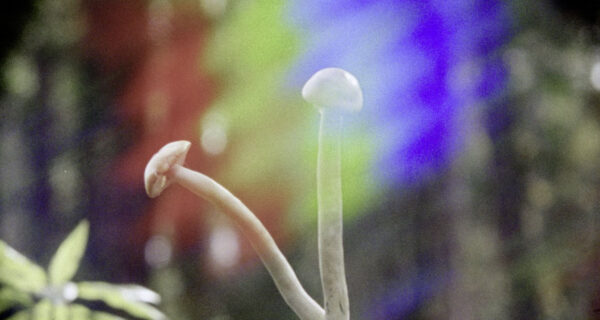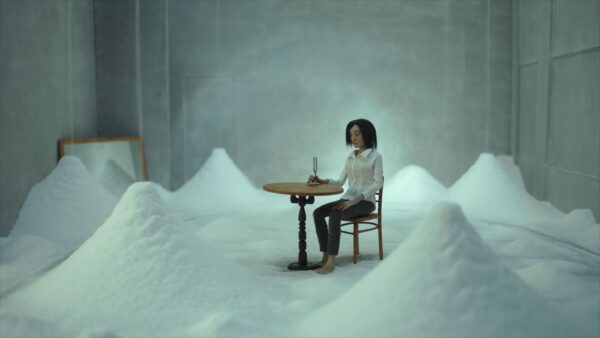Embracing The Silence
Night Walks
A father and daughter walk through a dark forest at night, listening to mysterious noises and looking up at the stars in Lizete Upīte’s delightfully minimalistic film.

A father and daughter walk through a dark forest at night, listening to mysterious noises and looking up at the stars in Lizete Upīte’s delightfully minimalistic Night Walks. With a restrained approach, the filmmaker explores forgotten childhood fears and experiences and delivers a touching portrait of embracing the unknown. We experience the piece through the eyes of a child, Anna, who stays close to her father’s side as she walks through the woods, holding onto a burning torch that illuminates her path ahead.
Anna is sensitive to the sounds of the forest, convincing herself that wild boars roam in the darkness. Her dad assures her the animals around them are “more afraid of [her].” In other moments, she seems unsure of what sort of creatures are producing these noises; perhaps they are paranormal or other-worldly. Anna’s father asks her why the noises are scary, she simply replies “I don’t know.” The film reminds us of our childhood imagination, especially in moments of terror, moving at breakneck speed and unable to settle on conclusions. It also refuses to reveal the sources of these noises. Instead, it lingers on shots of darkness, brilliantly animated with scratchy pencil strokes.
These black shots are an excellent use of the strange boiling effects of drawn animation, as we are looking at a darkness that doesn’t settle but twitches with a sense of life and possibility. Anna’s torchlight is animated in a similarly adventurous style, transforming the dancing flames of the light into bright petals or moth wings that bounce and shudder. This visual invention is another aspect of the film deceptively hidden by the overall simplicity of its approach, but it’s these details which give the short an immersive sense of fullness and life. Likewise, the design of Anna and her father is subtly unconventional, drawn with heads that fade away above the eyebrows, which only looks unnatural once they both move into the light of their house.
Despite her fear of the unseen, Anna’s sense of safety while walking with her father is a palpable emotion throughout the film. His presence is calming as he carefully considers his daughter’s theories about the dangers surrounding them. He doesn’t deny her fears but offers an alternative vision: a world where the wild boars of the forest are fearful of Anna and him, and shy wolves are hiding from the bright torchlight.
Her father’s reassuring presence is also felt through the textural sound design, highlighting the soft rustling of his knitted jumper and his steady footsteps crunching on the forest floor. Through this immersive sound, we feel the closeness of the two characters, the small, grounding details of their movements compared to the uncertain ambiance of the forest. The methodical sound of the character’s footsteps creates a hypnotic rhythm that pulses throughout the film. At moments, the sounds of Anna’s shoes on the forest floor mimic a heartbeat, quickening and slowing as she reacts to her surroundings—this careful attention to sound, one of the film’s key achievements, grounds the animation in a strong sense of reality. The noises of trees swaying in the wind or the creaking of a garden gate create an immersive collage of natural sounds, which contrast with the short’s illustrative visual style. Perhaps this heightened focus on the ambience of nature is linked to the film’s focus on darkness and the lack of sight. As the film robs us and the characters of their vision, the environmental sounds become more tactile and intense. Even the spoken words of Anna and her father are stripped back, reduced to short exchanges as they trudge through the silence. Scared by the quiet surrounding them, Anna asks her father if they should talk louder. “But then there’s no fun to walk through the forest,” he replies, encouraging Anna to see the forest as a place of listening, not speaking.
The torch that Anna holds can be seen as the film’s third character. Although it alleviates Anna’s fear of the forest, the torch is suggested to be an intrusion into their environment. The bright light scares the creatures surrounding them or entices them dangerously to its flames, like the moths that circle the light until one of them flies too close. With the torch by her side, the night sky above Anna becomes dark and obscured, overpowered by the fire’s glow. Her father softly encourages her to try walking without the torch. Like his encouragement to listen instead of speak within the forest, the torch’s light stops us from accepting the natural light provided by the moon and the sky and keeps us from the calmness of the dark. Only when the torch extinguishes itself does Anna notice the night sky above her, the natural light shining from the blanket of glowing stars. Now hypnotised by the night sky, Anna no longer jumps at the strange sounds of the forest, like a snapping branch in the distance. Ultimately, Anna and her father return to the light of their house, perhaps more welcoming of the warm glow after drinking in the darkness outside. Anna says they should return to the woods tomorrow night. “But without the torch, though,” suggests her father. She considers it, “Perhaps.”




There are no comments yet, be the first!